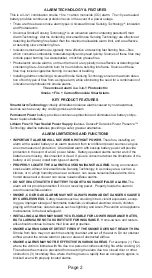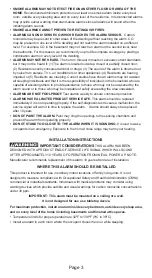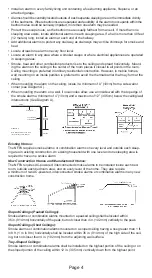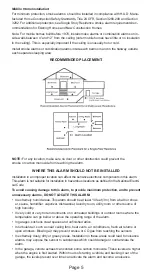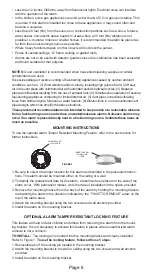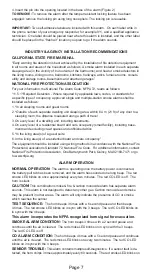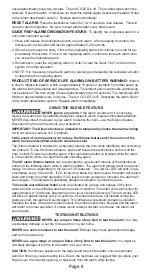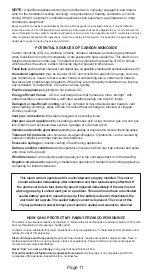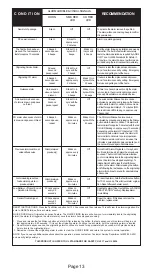
once approximately every two minutes . The red CO LED is off . The trouble signal cannot be
silenced . Reset the alarm . If this does not clear this trouble signal, deactivate the alarm . Refer
to the “alarm deactivation section.” Replace alarm immediately.
RESET ALARM:
Press the test/silence button for 10-15 seconds, then release . This will
clear the alarm origination . Be sure to reset alarms after every alarm event .
QUICK FIND
®
ALARM ORIGINATION FEATURE:
To identify the originating alarm in a
non-interconnected system
1 . Press and release the test/silence button on each alarm . After releasing the button, the
test sequence will sound and last for approximately 5-20 seconds .
2 . Once the test sequence ends, if this is the originating alarm will continue to sound for ap-
proximately 60 seconds . If it is not the originating alarm, continue to test each alarm until
you locate the originating alarm .
3 . Remember to reset the originating alarm in order to clear the Quick Find
®
and return the
system to normal operation
4. NOTE: It is necessary to test each alarm by pressing and releasing the test/silence button
to determine the originating alarm .
PRODUCT END-OF-SERVICE LIFE ALARM/LOW BATTERY WARNING:
When it
is time to replace this alarm, which is approximately 10 years of operation from initial power up,
the alarm will provide audible and visual warnings . The product end-of-service life warning can-
not be silenced . The horn chirps 2 times approximately every 60 seconds . The red smoke LED
blinks on approximately every 2 minutes . The red CO LED is off . Deactivate the alarm . Refer
to the “alarm deactivation section.” Replace alarm immediately.
USING THE SILENCE FEATURE
NEVER ignore any alarm.
If the alarm sounds and it is not being
tested, it is warning of a potentially dangerous situation which requires immediate attention .
NEVER disconnect the power to your alarm to silence the horn—use the Silence feature.
Disconnecting the alarm removes your protection!
IMPORTANT! The Silence feature is intended to temporarily silence the alarm warning.
It will not correct a smoke or CO problem .
In the event of a smoke alarm, do not use the Silence feature until the source of the
alarm has been identified and safe conditions exist.
The Silence feature is intended to temporarily silence the horn while identifying and correcting
the problem . To use the Silence feature, press and release the test/silence button until the
horn is silent if it was the initiating alarm . If the test/silence button is pressed while the alarm
is in the silence mode, the alarm will start sounding again .
The CO alarm Silence feature
can be activated by a press and release of the test/silence
button on the initiating alarm while in alarm condition . The alarm will remain silent for approxi-
mately 5 minutes, depending on the level of CO detected . The red CO LED will blink on ap-
proximately every 10 seconds . If CO levels drop below the alarm levels, the alarm will remain
silent and return to normal operation . If CO levels remain constant or increase, the alarm will
sound again . This indicates a potentially dangerous situation . Ventilate the area .
The smoke alarm Silence feature
can be activated by a press and release of the test/
silence button on the initiating alarm while in alarm condition . The alarm will remain silent for
approximately 8-12 minutes, depending on the level of smoke detected . The red smoke LED
will blink on approximately every 10 seconds . If smoke levels have not cleared during the
silence period, the alarm will sound again . This indicates a potentially dangerous situation .
Ventilate the area . If the alarm remains silent, the smoke levels have dropped and the alarm
will return to normal operation . If smoke levels remain constant or increase, the alarm will
sound again .
TESTING INSTRUCTIONS
NEVER use an open flame of any kind to test this alarm.
You may
accidentally damage or set fire to the alarm or to your home.
NEVER use vehicle exhaust to test the alarm!
Exhaust may cause permanent damage
and voids the warranty .
NEVER use a gas range or an open flame of any kind to test this alarm.
You might ac-
cidentally damage or set fire to the alarm or to your home.
CAUTION:
Continuous exposure to the high sound level of this alarm over an extended
period of time may cause hearing loss . Due to the loudness, we suggest that you place your
fingers over the sounder opening, or step back from the alarm while testing.
Page 8
Summary of Contents for MPC322S
Page 14: ...Page 14...


